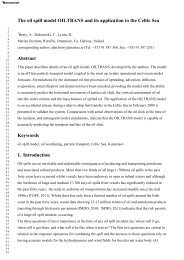Marine Industries Global Market Analysis - Marine Institute
Marine Industries Global Market Analysis - Marine Institute
Marine Industries Global Market Analysis - Marine Institute
You also want an ePaper? Increase the reach of your titles
YUMPU automatically turns print PDFs into web optimized ePapers that Google loves.
110 MARINE INDUSTRIES GLOBAL MARKET ANALYSIS<br />
Shipbuilding, like shipping, is a highly cyclical industry. At the time of its sixth report<br />
on the situation in world shipbuilding in late 2002, the European Commission had<br />
noted the impact of past over-ordering following a period of almost continuous<br />
growth from 1995 to 2000.The uncertainties in the world economy following the<br />
events of 11 September 2001 resulted in a fall in confidence and a major reduction in<br />
orders – 60% down in mid 2002 at 3 million CGT, compared with a quarterly peak<br />
of the 7.5 million CGT in mid 2000.<br />
In the EU the situation was even worse with a decline of 80% in new orders. 9/11<br />
also resulted in a major fall in orders for cruise ships, a European specialist sector.<br />
Between 2000 and 2002 the EU share of the world shipbuilding market fell from<br />
19% to 7% and the Chinese share grew from 7% to 13%.<br />
In 2002 the EU authorised direct aid of 6% to shipyards as a Temporary<br />
Defensive Mechanism.<br />
Although Ireland does not have a significant shipbuilding capability, it is necessary<br />
to understand the shipbuilding sector as it is a driver for others such as marine<br />
equipment, education & training, R&D, etc.<br />
20.4 TECHNOLOGICAL CHALLENGES<br />
Fuel price increases have resulted in growing pressures to reduce vessel operating costs<br />
and the major challenge is to radically improve propulsion efficiency. Engine emission<br />
reduction is also a significant challenge.<br />
20.5 THE LONG-TERM – 2010 ONWARDS<br />
The long-term is fundamentally a function of the growth in world seaborne trade,<br />
the underlying driver of shipping demand, which fuels owner confidence and results<br />
in more shipping orders.<br />
In recent years there has been an increase in the size of vessels but this may reach<br />
its practical limit as a function of ports’ capacity.<br />
Of increasing significance could be the growing desire in Europe, and to a lesser<br />
extent the US, to transfer road freight to short-sea shipping and this could result in<br />
an increase in orders for smaller vessels.

















